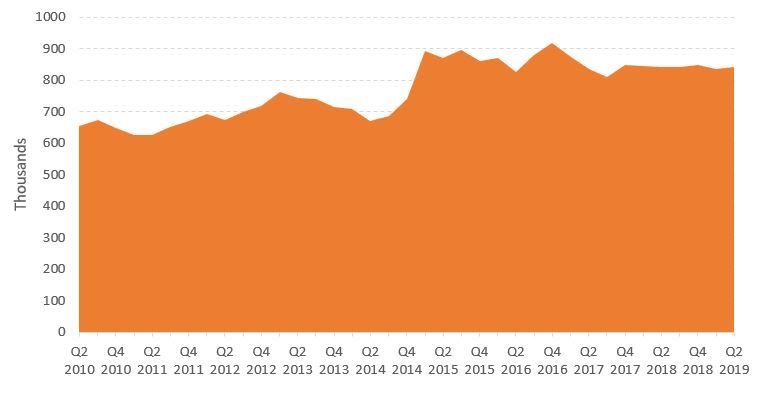
Subscribe & Follow
#AfricaMonth
In the news
Agricultural sector creates jobs despite unemployment rate rising

The number of unemployed people increased by 455 000 to 6.7 million in the second quarter, and this is significantly higher than the 4.3 million unemployed people about 10 years ago. The unemployment rate among youth is at the highest level of 56.4%, which is a serious ticking bomb. In his State of the Nation address, President Cyril Ramaphosa indicated that youth unemployment is a national crisis that demands urgent, innovative and coordinated solutions where all should see it as a requirement to work together.
Job cuts in the second quarter of 2019 were notable in private households (49 000), transport (42 000), mining (36 000) and financial services (21 000) sectors. The reduction in employment in the mining sector was mainly driven by losses in mining of non-ferrous metal ores. However, the agricultural sector was among those sectors that recorded employment gains during the period under review.
Agricultural jobs accelerate in Q2 2019 - understanding the context
The primary agricultural sector gained 5 000 jobs in Q2 2019 to a total of 842 000 compared to the previous quarter (see Figure 1 below below). The sub-sectors that experienced a notable increase in employment included the horticultural sectors, partly due to harvesting activity in the citrus industry.
While the second quarter agricultural employment data does not bring much excitement given that National Development Plan (NDP) envisaged the sector to create close to 1 million jobs by 2030, is argued that it is by no means an underperformance if compared to the average five-year employment of 814 000.
Figure 1: Employment in South Africa’s primary agricultural sector

From a regional perspective, the provinces that faced notable gains in agricultural jobs in Q2 2019 were Mpumalanga, Limpopo and Eastern Cape, which showed an increase of 32.2% (or 25,000 jobs) and 13.9% (or 17,000 jobs) and 15.2% (13,000 jobs), respectively (see Figure 2 below). This is mostly attributed to the seasonal jobs that were created in the citrus industry during the harvesting period. Meanwhile, Western Cape, one of the biggest agricultural employers, shed around 44,000 jobs in the second quarter of 2019.
Figure 2: Agricultural jobs by provinces

Following the trend in the second quarter of 2019, the number of women employed in the agricultural sector decreased by a further 30,000 in the second quarter of 2019, compared to a decline of 7,000 jobs during the first quarter. Contrary, the number of men employed accelerated by 35,000 during the same period, compared with a decline of 5,000 in the first quarter.
As a result, women’s share of employment in the agricultural labour force continues to decline, reaching 29.5% during the second quarter of 2019, compared to 33.2% in the first quarter of the year. This clearly indicates that men still largely dominate employment in the agricultural sector. The declining women’s’ share of agricultural jobs is of serious concern, especially given the government’s imperative to build an inclusive sector.
Very doubtful that the agricultural sector will create about 1 million jobs by 2030. The government has identified employment creation as one of its key priorities, with key sectors such as agriculture expected to play a central role in realising equitable and inclusive growth.
As the primary economic activity in rural areas, the National Development Plan (NDP) recognises the agricultural sector as having the potential to create close to one million new jobs by 2030, placing it front and centre as the leading contributor to the overall employment target.
Since the adoption of NDP by Cabinet in 2012 as a long-term vision and plan for the country, the agricultural sector has only created around 131,000 jobs (i.e. agricultural jobs were 718 000 in Q4 2012 compared with 849,000 in Q4 2018), thus leaving one to doubt if the sector will ever be able to create the targeted one million jobs by 2030.
To try and make a significant progress in achieving this target of one million agricultural jobs target by 2030, although it seems impossible at this state, the underutilised land in the former homelands (i.e. KwaZulu-Natal, Eastern Cape and Limpopo which are estimated to collectively have between 1.6 to 1.8 million hectares of underutilized land) and underperforming land reform farms need to be brought into full production with a key focus on labour-intensive sub-sectors in the horticultural sector which currently employs majority of the primary agriculture labour force.










